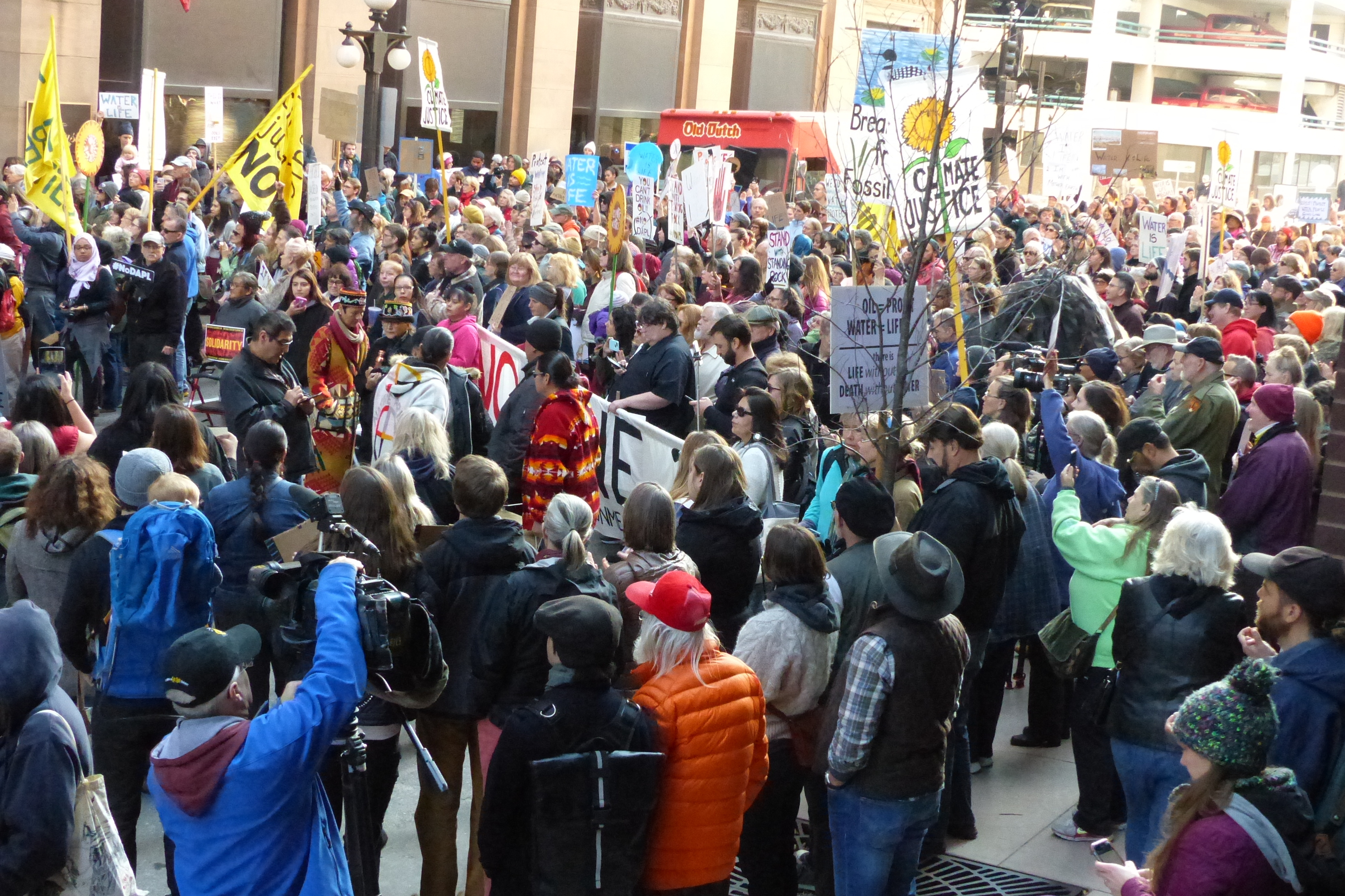 by Scott Russell
by Scott Russell
Hundreds of people opposed to the Dakota Access Pipeline (DAPL) gathered in downtown St. Paul on November 15, calling on President Obama to do everything in his power to permanently reject the Dakota Access Pipeline (DAPL). The St. Paul rally was part of a National Day of Action against DAPL, joining more than 200 similar rallies around the country, from Los Angeles and Denver to Manhattan and the White House.
These events showed solidarity with Indigenous leaders and supported Native sovereignty. The pipeline is cutting through the Standing Rock Nation’s sacred and historical land and threatening its drinking water. The rallies also denounced the heavily military response against the peaceful water protectors and strengthened the fossil fuel resistance movement to fight back under a Trump administration.
Locally, the rally started in Mears Park with a Native prayer and drum circle. Participants carried colorful homemade signs such as “We Stand with Standing Rock,” “Water is Sacred” and “Climate Justice,” and chanted in a call-and-response, “Mni Wiconi … Water is Life!” People then marched to the nearby local headquarters of the U.S. Army Corps of Engineers — an agency that holds the key to stopping the project. Pipeline owner Energy Transfer Partners needs an easement from the Corps to bore under the Missouri River. A day before the rally, the Corps announced that the project needed more study.
Sponsors of the St. Paul rally ranged from the Indigenous Environmental Network and Honor the Earth to the Sierra Club and Friends of the Earth. Following the rally, approximately 50 people splintered off and marched and chanted at Wells Fargo Place. It was an effort to draw attention to the fact that Wells Fargo is one of the 38 financial institutions providing credit to the pipeline company. This is part of an effort to embarrass these companies – which often tout their green energy investments -- into pulling their funding from such a dirty energy proposal. (This effort has had recent success. DNB, the largest bank in Norway, is now selling its assets in the pipeline and is rethinking its loans.)
Here are three takeaways from the rally:
Takeaway #1: This was an indigenous-led event and people are following their lead. Kelly Sherman-Conroy (Oglala Lakota), a student at Luther Seminary, was one of the speakers. She told how she traveled to Standing Rock with hundreds of other religious leaders Nov. 3 to stand in solidarity with the water protectors trying to stop the pipeline. She told the Mears Park crowd: “We are here to stand in prayerful action … We are here to lift up our Indian brothers and sisters today.”
Takeaway #2: Don’t let anger consume you. Mary Lyons, an Anishinaabekwe elder, gave a powerful speech about doing this work with a good heart. She asked people to pray for “all the people destroying this world. … Pray for their spirit to awake.” She cautioned people: “Don’t walk in that space of anger. … Don’t. That is feeding the beast. You are losing yourself.”
Takeaway #3: DAPL would be a climate disaster. It would carry dirty fracked oil from North Dakota to Illinois. Tara Houska, National Campaign Director of Honor the Earth, said: “Climate change is happening now. … The delays and noncommittal statements from the Obama administration are disappointing to say the least. We want answers. Conduct an Environmental Impact Statement and halt the construction of this destructive project.”
The rally provided a temporary emotional uplift for those opposed to this project. Of great concern is that in the week since the rally, violence at Standing Rock is escalating, with law enforcement using water cannons against the water protectors in freezing conditions. There is much work to be done to stop the violence and stop the pipeline.
Scott Russell is a volunteer leader with the Beyond Oil and Tar Sands Committee.